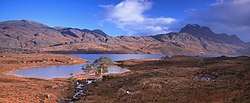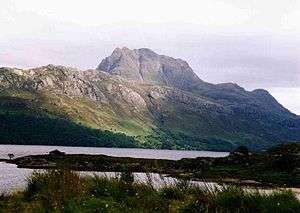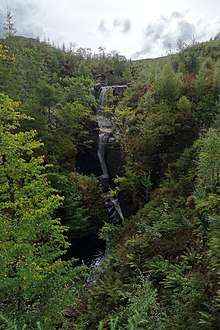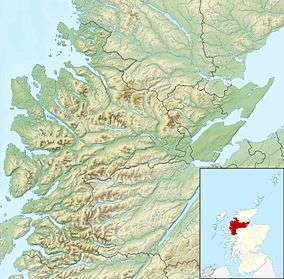Loch Maree
Loch Maree (Scottish Gaelic: Loch Ma-ruibhe)[7] is a loch in Wester Ross in the Northwest Highlands of Scotland. At 21.7 km (13.46 mi) long[1] and with a maximum width of 4 km (2.5 mi), it is the fourth largest freshwater loch in Scotland; it is the largest north of Loch Ness. Its surface area is 28.7 km2 (11.08 sq mi).[2]
| Loch Maree | |
|---|---|
 Panorama of Loch Maree, with Slioch in the background. | |
| Location | Northwest Highlands, Scotland |
| Coordinates | 57°41′23″N 5°27′27″W |
| Catchment area | Beinn Eighe, Slioch, Fisherfield, Glen Docherty, Coulin, Slattadale, Talladale |
| Basin countries | United Kingdom |
| Max. length | 21.66 km (13.46 mi)[1] |
| Max. width | 4 km (2.5 mi) |
| Surface area | 28.7 km2 (11.08 sq mi)[2] |
| Average depth | 38 m (125 ft)[3] |
| Max. depth | 112 m (367 ft)[4] |
| Water volume | 1.09 km3 (38.5×109 cu ft)[5] |
| Islands | 60 |
| Designated | 19 September 1994 |
| Reference no. | 700[6] |
Loch Maree contains five large wooded islands and over 60 smaller ones,[8][9] many of which have their own lochans. The largest island, Eilean Sùbhainn, contains a loch that itself contains an island,[10] a situation that occurs nowhere else in Great Britain. Isle Maree holds the remains of a chapel believed to be the 8th century hermitage of Saint Máel Ruba (d. 722), who founded the monastery of Applecross in 672.[11] It is after him that Loch Maree is named; prior to the saint's arrival in the area the loch is believed to have been named Loch Ewe, as evidenced by the name of the village of Kinlochewe (Scottish Gaelic: Ceann Loch Iù, meaning "Head of Loch Ewe") which is located at the eastern end of Loch Ewe.[12]
The loch is important for wildlife. It is the site of one of the largest breeding concentrations of black-throated diver in Great Britain, and also hold an important population of otter. The islands of Loch Maree are the location of some of the best native Caledonian pinewood in Scotland, and are particularly noted for their dragonflies, with 12 species having been recorded.[13] The waters, islands and shoreline of Loch Maree are protected by several overlapping conservation designations.
Geography

Loch Maree is much longer than it is wide, stretching along a northwest-southeast axis. The outflow is via the short River Ewe, through which water enters the sea loch of Loch Ewe, close to the village of Poolewe; the village of Kinlochewe lies at the head of the loch at the southeastern end. The A832 road between the two runs along much of the southwestern shore of the loch, but diverges from it in the north to run via Gairloch, along the coast from Poolewe.[10]
Loch Maree is divided into three main basins, and has many islands: the ratio of the area of the islands to the area of the surface water is greater than any other large loch in Scotland.[14] The deepest of the basins, at 112 m (367 ft), is known as the Grudie Basin, and lies between Isle Maree and the head of the loch. To the northwest of this basin lies the Slattadale Basin, which contains the majority of the islands. North of the islands lies a shallower area, separating the Slattadale Basin from the Ardlair Basin, the most irregularly shaped of the three.[12]
The most prominent mountain on the northern side of Loch Maree is Slioch, one of Scotland's Munros (a mountain over 3,000 ft (910 m) high), which dominates the eastern end of the loch above Kinlochewe. It is composed mainly of Torridonian sandstone of Precambrian age, lying on a bedrock of Lewisian gneiss. It is popular for hill walking, scrambling and climbing.[15] Other peaks on the northern side include Beinn Àirigh Charr and Beinn Làir, both of which are classified as Corbetts.[16] The entire length of the northeastern shore of Loch Maree forms part of the 35,072 ha (86,664 acres) Letterewe, Heights of Kinlochewe & Tournaig Estate, which extends north over an area known as the Fisherfield Forest.[17] The southwestern side of Loch Maree is also mountainous, comprising the Torridon Forest. The most prominent peak is Beinn Eighe, which is capped with white quartzite.[18] Three main landowners occupy the southwestern shore: from south to north these are Scottish Natural Heritage (the Beinn Eighe National Nature Reserve), the 5,154 ha (12,737 acres) Grudie & Talladale Estate,[19] and the 21,701 ha (53,625 acres) Gairloch (Flowerdale & Shieldaig) & Conon Estate.[20]
History

Between 671 and 722 Máel Ruba arrived at Loch Maree, and founded a chapel on Isle Maree. Remains of this chapel were reportedly still visible in 1861 but no traces now remain, although the burial ground associated with the chapel is still extant. A small covered well on the island is said to have been consecrated by the saint.[11]
During the middle ages the island of Eilean Ghrùididh on Loch Maree was a centre for the MacBeaths; in or shortly after 1430 the MacBeaths were displaced by Clan MacLeod. Investigation of the island in 1965 found a fortified area measuring 44 by 36 metres with walls 1 m thick and 2 m high, with a 1.8 m deep dungeon in the southeast corner. No buildings were found within the fortifications.[21]
Due to its remote location there is now little industry surrounding Loch Maree, however the area was formerly a centre for ironworking. During the seventeenth century up to 8 hectares of oak woodlands a day were turned into charcoal to fuel the smelting of bog iron at Letterewe on the northeast shore.[12] Workmen from these iron furnaces are said to have been buried on Isle Maree.[11] Remains of one iron furnace can be seen at a site known as the Red Smiddy on the northeast bank of the River Ewe between the outflow from the loch and Poolewe. Pieces of ore, slag and iron have been found at this site.[22]
The loch became a popular spot for trout fishing after Queen Victoria visited the Loch Maree Hotel at Talladale in 1877,[23] a visit which led to the naming of Victoria Falls, an attractive waterfall in the vicinity of the hotel.[24] In 1893, there was a proposal to build a branch railway from Achnasheen to Aultbea along the south shore of Loch Maree. The railway would have increased Victorian tourist traffic, as well as providing a service for fisheries and the mail and a connection to Stornoway, however the plan was later abandoned.[25]
Ecology
Loch Maree is of international importance for its special wildlife and biodiversity, and is the site of one of the largest breeding concentrations of black-throated diver in Great Britain.[13]
Sea trout and salmon are an important part of the loch's ecosystem, providing food for black-throated diver and otter (Lutra lutra): juvenile trout can be an important part of the diet of black-throated diver.[26] Until recently, thousands of adult sea trout (seagoing brown trout Salmo trutta) and salmon (Salmo salar) returned to the loch from the sea every summer. Sea trout gathered in huge numbers in certain bays, providing some of the most exciting angling in Scotland for which the loch had an international reputation. A British record sea trout of 19.5 lb (8.8 kg) was caught on a "dapping fly" in the loch in 1952.[27] The sea trout fishery collapsed in the 1980s and 1990s.[28] The loch also has two separate populations of Arctic charr (Salvelinus alpinus) about which little is known. One form of charr, with a big eye which feeds on the bottom in deep water matures at less than 15 cm. The other form grows to over 32 cm and can sometimes be seen in shoals ruffling the surface when the loch is calm.[29]
The islands of Loch Maree are wooded, being the location of some of the best native Caledonian pinewood in Scotland. These woodlands, along with others in Wester Ross, are genetically distinct from other pinewoods in Scotland, showing more similarity to those in southern Europe.[13] It is thought that this results from the fact that western Scotland became ice-free first at the end of the last ice-age, allowing pine to move north along the western fringe of Europe. Pines reached Eastern Scotland from more northerly areas during a later period, as the ice sheets retreated further.[30] Scots pine are the dominant species in these woodlands, however other tree species such as rock whitebeam and juniper are also present. The islands of Loch Maree are particularly noted for their dragonflies, with 12 species having been recorded, including the northern emerald, azure hawker and white-faced darter.[13] Pine martens and white-tailed sea eagles can be found on the islands,[31] which are also a breeding site for redwings; greylag geese were known to breed here in the past, but have not done so since the 1970s.[32]
Conservation designations
| Loch Maree Islands National Nature Reserve | |
|---|---|
IUCN category IV (habitat/species management area) | |
 Amongst the islands of Loch Maree. | |
 | |
| Location | Wester Ross, Scotland |
| Coordinates | 57.694°N 5.509°W |
| Area | 200 ha[33] |
| Established | 1977[34] |
| Governing body | Scottish Natural Heritage (SNH) |
| Beinn Eighe and Loch Maree Islands National Nature Reserve | |
The presence of black-throated divers on the loch has led to it being designated as Special Protection Area (SPA) under the EU Habitats Directive.[35] The loch is also designated as a Special Area of Conservation (SAC), forming part of the Loch Maree Complex SAC, which extends to cover the surrounding hills including Beinn Eighe.[36]
Over 60 islands within the loch are designated as the Loch Maree Islands National Nature Reserve (NNR),[33] which has since 2014 been jointly managed with the neighbouring Beinn Eighe NNR as a single reserve.[37] The Beinn Eighe and Loch Maree Islands NNR forms part of the designated Core Zone of the Wester Ross UNESCO Biosphere reserve.[38]
Loch Maree is classified as a Category IV protected area by the International Union for Conservation of Nature,[34] and has been designated as a Ramsar site since 19 September 1994.[39] It is also a Site of Special Scientific Interest (SSSI),[13] and lies within the Wester Ross national scenic area.[40]
In media
Button-box accordionist, Fergie MacDonald topped the Scottish pop charts in 1966 with the tune "Loch Maree Islands"[41] which pays tribute to the views of the loch, and vocal versions have been recorded by many artists over the years, notably Calum Kennedy.[42] More recently a version of the song was included on Peat and Diesel's 2019 album Uptown Funk.[43]
In the 2009-10 series of the BBC's Natural World, episode 6, Highland Haven, stayed closer to home than usual, with a year-long look at the environment and wildlife of Loch Maree and its surroundings.[44][45]
Loch Maree is mentioned in the Runrig song "The Summer Walkers" from the album The Stamping Ground.[46]
- And it's up by the Shin
- And up by the 'Naver
- And the long winding shores Of Loch Maree
- By Ben Hope and Ben Loyal
- Stack and by Arkle
- The road reaches far
- Now the summer is here
Folklore
Thomas Pennant, writing in 1772, recorded that the waters of the loch were thought to have curative effects, with being submerged in the water thought to be a cure for lunacy.[12]
Isle Maree holds an oak wish tree made famous by a visit in 1877 by Queen Victoria mentioned in her published diaries. The tree, and others surrounding it, are festooned with hammered-in coins. It is near the healing well of St. Máel Rubha, to which votive offerings were made, including the sacrifice of bulls, which continued up to the 18th century, according to records,[47] leading to speculation that the island was a place of pre-Christian pagan worship which was taken over by the saint.[11] The same island contains ancient stands of oak and holly which have been linked with ancient Scottish druids.
Like Loch Ness, Loch Maree has its own monster in the form of the muc-sheilch.
References
- Bathymetrical Survey of the Fresh-Water Lochs of Scotland, 1897-1909. Volume I, Table 1.
- Bathymetrical Survey of the Fresh-Water Lochs of Scotland, 1897-1909. Volume I, Table 2.
- Bathymetrical Survey of the Fresh-Water Lochs of Scotland, 1897-1909. Volume I, Table 4.
- Bathymetrical Survey of the Fresh-Water Lochs of Scotland, 1897-1909. Volume I, Table 3.
- Bathymetrical Survey of the Fresh-Water Lochs of Scotland, 1897-1909. Volume I, Table 5.
- "Loch Maree". Ramsar Sites Information Service. Retrieved 25 April 2018.
- "Database - Loch Maree". Ainmean-Àite na h-Alba. Retrieved 2019-02-07.
- "Loch Maree Islands - Scotland's National Nature Reserves". Nnr-scotland.org.uk. 14 April 2014. Archived from the original on 27 January 2016. Retrieved 7 November 2016.
- "Loch Maree Wester Ross – Scotland Info Guide". Scotlandinfo.eu. 20 June 2014. Retrieved 7 November 2016.
- Ordnance Survey. 1:25000 Explorer map. Sheet 433, Torridon - Beinn Eighe & Liathach.
- Historic Environment Scotland. "Isle Mare (12049)". Canmore.
- Tom Weir (1980). The Scottish Lochs. Constable. pp. 155–163. ISBN 978-0094632707.
- "Loch Maree SSSI Citation". Scottish Natural Heritage. Retrieved 2018-11-02.
- Bathymetrical Survey of the Fresh-Water Lochs of Scotland, 1897-1909. Volume II, Page 211.
- Donald Bennet & Rab Anderson, ed. (2016). The Munros: Scottish Mountaineering Club Hillwalkers' Guide. Scottish Mountaineering Trust. p. 221. ISBN 9780907521945.
- Rob Milne & Hamish Brown, ed. (2016). The Corbetts and Other Scottish Hills. Scottish Mountaineering Trust. p. 211–212. ISBN 9780907521716.
- "Property Page: Letterewe, Heights of Kinlochewe & Tournaig". Who Owns Scotland. Retrieved 2018-11-05.
- Donald Bennet & Rab Anderson, ed. (2016). The Munros: Scottish Mountaineering Club Hillwalkers' Guide. Scottish Mountaineering Trust. p. 217. ISBN 9780907521945.
- "Property Page: Grudie & Talladale". Who Owns Scotland. Retrieved 2018-11-05.
- "Property Page: Gairloch (Flowerdale & Shieldaig) & Conon". Who Owns Scotland. Retrieved 2018-11-05.
- Historic Environment Scotland. "Eilean Ghruididh (12046)". Canmore.
- Historic Environment Scotland. "Red Smiddy Iron Works (11940)". Canmore.
- Unattributed (3 September 1879). "A Highland Loch". The Times (29663). p. 6.
- Black's Guide to Scotland. Published by Adam & Charles Black, London. 1903. p. 466.
- John A. McGregor (2005). The West Highland Railway: Plans, Politics and People. John Donald Publishers. ISBN 978-0859766241.
- Jackson, Digger B. (2005). "Browse journals by subject". Bird Study. 52 (3): 225–236. doi:10.1080/00063650509461396.
- "Loch Maree Hotel: The best in Western Scotland". Malcolm Mowat's. Retrieved 24 January 2016.
- "Wester Ross Fisheries Trust: Sea Trout". Retrieved 24 January 2016.
- ADAMS, COLIN E.; WILSON, ALASTAIR J.; FERGUSON, MOIRA M. (2008-12-01). "Parallel divergence of sympatric genetic and body size forms of Arctic charr, Salvelinus alpinus, from two Scottish lakes". Biological Journal of the Linnean Society. 95 (4): 748–757. doi:10.1111/j.1095-8312.2008.01066.x. ISSN 0024-4066.
- "The Story of Beinn Eighe and Loch Mare Islands National Nature Reserve" (PDF). Scottish Natural Heritage. 2008. p. 5. Retrieved 2018-10-05.
- "The Story of Beinn Eighe and Loch Mare Islands National Nature Reserve" (PDF). Scottish Natural Heritage. 2008. p. 2. Retrieved 2018-10-05.
- "The Story of Beinn Eighe and Loch Mare Islands National Nature Reserve" (PDF). Scottish Natural Heritage. 2008. p. 14. Retrieved 2018-10-05.
- "Site Details for Loch Maree Islands NNR". Scottish Natural Heritage. Retrieved 2018-11-01.
- "Loch Maree Islands in United Kingdom of Great Britain and Northern Ireland". Protected Planet. 2007. Retrieved 2018-11-02.
- "Site Details for Loch Maree SPA". Scottish Natural Heritage. Retrieved 2018-11-01.
- "Site Details for Loch Maree SAC". Scottish Natural Heritage. Retrieved 2018-11-01.
- "The Management Plan for Beinn Eighe and Loch Maree Islands NNR 2015-2025" (PDF). Scottish Natural Heritage. 2018. p. 3. Retrieved 2018-11-01.
- "Wester Ross Biosphere Reserve Application" (PDF). Wester Ross Biosphere Ltd. September 2015. Retrieved 2018-07-05.
- "Loch Maree". Ramsar Sites Information Service. 2006. Retrieved 11 February 2017.
- "Wester Ross NSA". Scottish Natural Heritage. Retrieved 2019-02-03.
- "Fergie MacDonald - Scottish Traditional Music Hall of Fame". Scottish Traditional Music Hall of Fame.
- "Calum Kennedy - The Calum Kennedy Show". Discogs. Retrieved 2019-01-24.
- "Albums". Peat and Diesel. Retrieved 28 January 2020.
- Interview on Two Lochs Radio, 27 November 2009.
- "Natural World (2009-10), Episode 6: A Highland Haven". BBC. Retrieved 2018-11-12.
- "Archived copy". Archived from the original on 4 February 2012. Retrieved 4 January 2012.CS1 maint: archived copy as title (link)
- Sharp, Mick (1997). Holy Places of Celtic Britain. Blandford. ISBN 1-85079-315-8. P. 149.
Sources
| Wikimedia Commons has media related to Loch Maree. |
- "Loch Maree Islands". Scottish Natural Heritage. Archived from the original on 16 July 2011. Retrieved 19 October 2010.
- Chisholm, Hugh, ed. (1911). . Encyclopædia Britannica (11th ed.). Cambridge University Press.
- Sir John Murray & Laurence Pullar (1909). "Bathymetrical Survey of the Fresh-Water Lochs of Scotland, 1897-1909". National Library of Scotland. Retrieved 2018-11-05.CS1 maint: uses authors parameter (link)